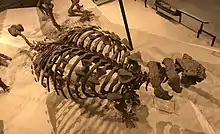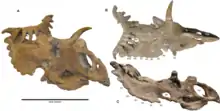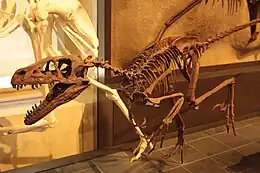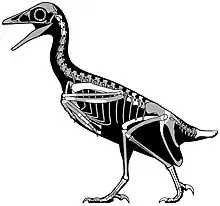| Kaiparowits Formation | |
|---|---|
| Stratigraphic range: Campanian | |
| Type | Geological formation |
| Thickness | 790 m (2,600 ft) |
| Lithology | |
| Primary | Mudstone, sandstone |
| Location | |
| Coordinates | 37°24′0″N 111°41′0″W / 37.40000°N 111.68333°W |
| Region | |
| Country | |
The Kaiparowits Formation is a sedimentary rock formation found in the Kaiparowits Plateau in Grand Staircase–Escalante National Monument, in the southern part of Utah in the western United States. It is over 2800 feet (850 m) thick, and is Campanian in age. This Upper Cretaceous formation was formed from alluvial floodplains of large rivers in coastal southern Laramidia; sandstone beds are the deposit of rivers, and mudstone beds represent floodplain deposits. It is fossiliferous, with most specimens from the lower half of the formation, but exploration is only comparatively recent, with most work being done since 1982. It has been estimated that less than 10% of the Kaiparowits formation has been explored for fossils. Most fieldwork has been conducted by The Natural History Museum of Utah.
Age
Traditionally, the Kaiparowits Formation has been considered to be roughly equivalent in age to the northern Dinosaur Park Formation. This, combined with the differences in fauna between the two formations, has led some scientists, most notably Scott Sampson, to conclude that there was some kind of barrier separating northern and southern Laramidia at this time. However, preliminary re-calibration of late Cretaceous formation correlations suggests that the upper part of the Kaiparowits, where many of the unique species are found, is actually younger than the Dinosaur Park, and that some Kaiparowits species may in fact simply be descendants of Dinosaur Park species.[1] However, new dates reveal that this is simply an artifact of inaccurate Ar-Ar dating, and both formations had similar ages.[2]
According to new Uranium-Lead stratigraphic data, the Kaiparowits dates from about 77.3 to 74.9 million years ago.[2]
Biostratigraphy
The timeline below follows the re-calibrated timeline of Fowler (2017),[1] showing species from the Kaiparowits Formation in green, and related species from Alberta in blue.
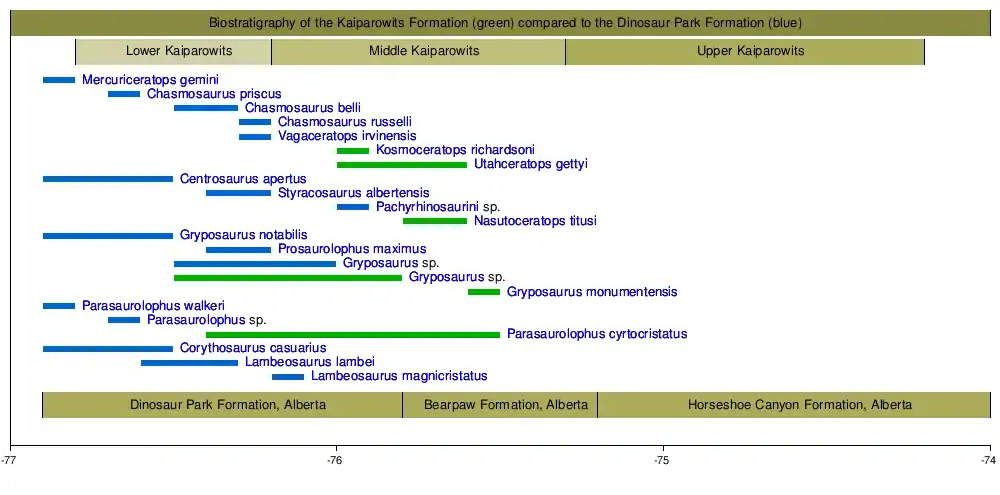
Habitat
The Kaiparowits Formation is a muddy bed that was deposited between about 77.3 to 74.9 million years ago,[2] in the area where the Grand Staircase–Escalante National Monument of Utah is today. It is extremely fossil rich, with thousands of plants and animal fossils being preserved in amongst its sandstone and mudstone deposits. Based on plants remains including multiple vines, leaves, and branches, It was assumed by paleontologists Scott Sampson and his colleagues that Utah in the Campanian was a dense jungle bordering the Western Interior Seaway. The jungle theory would also support why almost all the animals in the Kaiparowits Formation were new species, and why the deposits were so plentiful. Without the need for herbivores to migrate to find food, and theropods to migrate after herbivores, a whole ecosystem could evolve secluded from interbreeding. The theory also supported why the dinosaurs adorned such features like the 15 horns of Kosmoceratops, they were for sexual selection.[3]
Paleofauna
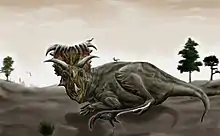
Animals present include chondrichthyans (sharks and rays), gars, bowfin, sturgeons, frogs, salamanders, turtles, lizards, crocodilians (including Deinosuchus),[4][5] coelurosaurian theropods such as dromaeosaurids, troodontids, and Ornithomimus velox, armored dinosaurs, the duckbill Parasaurolophus cyrtocristatus, and a variety of early mammals including multituberculates, marsupials, and insectivorans.[6] Recent finds include large specimens of the duckbill Gryposaurus,[7] including the species G. monumentensis,[7] and the first described remains of the oviraptorosaurian Hagryphus giganteus.[8]
Trace fossils are also known from the Kaiparowits, including an excellently preserved hadrosaur skin impression known from a recent analysis by Herrero and Farke.[9]
Turtles
Color key
|
Notes Uncertain or tentative taxa are in small text; |
| Turtles reported from the Kaiparowits Formation | ||||||
|---|---|---|---|---|---|---|
| Genus | Species | Location | Stratigraphic position | Material | Notes | Images |
|
Boremys[10] |
B. grandis[10] |
A baenid |
||||
|
A. goldeni |
A baenid, notable for its atypical nasal structure. | |||||
|
D. nodosoa |
middle unit of the upper Kaiparowits Formation |
A baenid | ||||
|
Two species[11] |
A baenid | |||||
|
Thescelus[11] |
int.[11] |
A baenid | ||||
|
C. victa[12] |
||||||
|
indet., possibly several species[10] |
An adocid | |||||
|
B. nobilis[12] |
A possible member of Nanhsiungchelyidae. By far the largest native turtle at about 78 centimeters in length. | |||||
|
Helopanoplia[10] |
indt.[10] |
|||||
Neosuchians
Color key
|
Notes Uncertain or tentative taxa are in small text; |
| Crocodilians reported from the Kaiparowits Formation | ||||||
|---|---|---|---|---|---|---|
| Genus | Species | Location | Stratigraphic position | Material | Notes | Images |
|
May not be Bernissartia proper, but a close cousin. It would extend the family's time range to the Campanian. |
| ||||
|
Alligatoroid[14] |
|
Is similar in form to Allognathosuchus. | ||||
|
A new species yet to be described. Reached around 2 meters in length and is known from skull bones and a partial juvenile skeleton. | |||||
|
Caimanine[14] |
|
Known from a lower jaw fragment. Is the oldest known true caiman found. | ||||
|
A very large alligatoroid, almost or over 10 meters in length. | |||||
|
A very large alligatoroid, similar in size to D. hatcheri. | |||||
|
Goniopholid[14] |
|
A new genus that exceeded 3 meters in length. Has a thin snout suited for piscivory. | ||||
|
A new species known from a partial skeleton | |||||
Ornithischians
Color key
|
Notes Uncertain or tentative taxa are in small text; |
| Ornithischians reported from the Kaiparowits Formation | ||||||
|---|---|---|---|---|---|---|
| Genus | Species | Location | Stratigraphic position | Material | Notes | Images |
|
A. johnsoni[18] |
Horse Mountain Gryposaur Quarry[18] |
Lower middle unit |
A complete skull, both mandibles, predentary, dorsal vertebrae, dorsosacral vertebrae, sacral vertebrae, caudosacral vertebrae, caudal vertebrae, dorsal ribs, a complete tail club, both scapulae, coracoid, humerus, ulna, partial ilium, femur, tibia, fibula, phalanx, partial cervical osteoderm half rings, and dorsal and lateral osteoderms.[18] |
A species of ankylosaurine related to Nodocephalosaurus.[18] |
 "Skaladromeus" | |
| Ankylosauridae[19] | Indeterminate[19] | A partial left mandible, a disarticulated forelimb consisting of a fused scapulocoracoid, humerus, radius, ulna, metacarpals, manual phalanx and an ungual, a scapula, coracoid, cervical vertebrae, caudal vertebrae, dorsal centra vertebrae, sacral vertebrae, chevrons, a complete cervical half ring, dorsal ribs, a partial tail club, numerous osteoderms and teeth.[19] | An indeterminate ankylosaurid known from various partial specimens.[19] | |||
| Anodontosaurus[19][20] | sp. nov.[20] | UMNH VP locality 1506[20] | Lower middle unit[20] | An isolated partial skull lacking the left lateral-most portion and much of the anterodorsal and posteroventral palate.[20] | Described in a thesis, different from the other two Anodontosaurus species.[20] | |
| Brachylophosaurini[21] | Indeterminate[21] | Lower unit[21] | An isolated jugal.[21] | The youngest example of brachylophosaurin material from Laramidia.[21] | ||
| Centrosaurinae[22] | Indeterminate[22] | Middle unit[22] | A partial skull and an isolated right squamosal.[22] | Also known as "Kaiparowits Centrosaurine B." Different from Nasutoceratops.[22] | ||
| Chasmosaurinae[22] | Indeterminate[22] | Dog Flat[22] | Lower unit[22] | Right side of an articulated partial skull, including the ventral lacrimal, jugal, epijugal, quadratojugal, postorbital, maxilla, squamosal, and rostrolateral parietal in the region of the supratemporal fenestra.[22] | Might be a distinct taxon based on its episquamosal and squamosal morphology.[22] | |
| Middle unit[21] | A mostly complete skull, a partial subadult skull, a partial skull roof and partial braincase, a partially articulated skeleton consisting of a portion of the skull and lower jaws, most of the dorsal, sacral, and caudal vertebral series, fragmentary ribs, scapulae, coracoid, humerus, and the entire pelvis, and a partial skeleton consisting of dorsal, sacral, and caudal vertebral series, a number of ribs, scapula, humerus, radius, ulna, and a complete pelvis.[21] |
A kritosaurin saurolophine hadrosaur. Gryposaurus is the most common hadrosaur found in this formation.[24] | ||||
| G. sp.[21] | Lower unit[21] | Several specimens including a virtually complete articulated skull and a fragmentary skull.[21] | May be referable to G. notabilis as the only difference is size and stratigraphy, the Kaiparowits specimens being much larger and more recent.[21] | |||
| Hadrosaurinae[21] | Indeterminate[21] | Lower unit | An articulated tail, partial pelvis, and left leg.[21] | An indeterminate hadrosaurine, initially interpreted as a lambeosaurine.[21] | ||
|
K. richardsoni[25] |
Lower middle unit[25] | A nearly complete skull and a disarticulated skull of a subadult individual.[25] |
A chasmosaurine ceratopsid with ten hook-like processes on the hind margin.[25] | |||
| Lambeosaurinae[26] | Indeterminate | Two partial skeletons | Similar to Hypacrosaurus altispinus; different from Parasaurolophus | |||
|
N. titusi[27] |
UMNH VP Locality 940[27] |
Lower middle unit[27] |
An almost complete skull, a disarticulated adult skull, an isolated squamosal, a syncervical, fragmentary dorsal vertebrae, associated left forelimb and fragmentary right forelimb.[27] |
A centrosaurine ceratopsid with rounded horns above its eyes.[27] | ||
| Nodosauridae[19] | Indeterminate[19] | Middle unit[19] | A cervical spine, numerous osteoderms, and teeth.[19] | Indeterminate nodosaurid remains.[19] | ||
| Ornithopoda[21] | Indeterminate[21] | [Six] disarticulated specimens and [one] articulated specimens, including articulated left and right feet from a single individual.[21] | One specimen shares similar foot morphology with Orodromeus, Oryctodromeus and Zephyrosaurus.[21] | |||
| Parasaurolophus[28] | Lower to middle unit[21] | [Eight] isolated partial skulls, a partial skeleton consisting of mostly the pelvic region, fragmentary associated elements, and a juvenile specimen consisting of a partial skull and articulated skeleton.[21] |
Originally identified as P. cyrtocristatus, then believed to be a new species, then tentatively referred back to P. cyrtocristatus. | |||
| "Skaladromeus"[31] | "S. goldenii"[31] | Lower to middle unit[31] | A partial disarticulated skull and fragmentary postcranial material.[21][31] | An orodromine ornithopod described in a thesis.[31] | ||
|
U. gettyi[25] |
Lower to middle unit[25] | [Two] partially complete skulls, a partial postorbital consisting of the nearly complete supraorbital horncore, an isolated rostrum, premaxilla, nasal fragment, jugal, squamosal and parietal, an associated post cranium, and two immature specimens consisting of partial postorbitals with complete supraorbital horncores.[25] |
A chasmosaurine ceratopsid known from adult and juvenile specimens.[25] | |||
Theropods
Color key
|
Notes Uncertain or tentative taxa are in small text; |
| Theropods reported from the Kaiparowits Formation | ||||||
|---|---|---|---|---|---|---|
| Genus | Species | Location | Stratigraphic position | Material | Notes | Images |
| cf. Dromaeosaurus[32] | Indeterminate[32] | Isolated teeth[32] | A dromaeosaurine dromaeosaurid only represented by isolated teeth.[32] | |||
| Dromaeosauridae[32] | Indeterminate[32] | An isolated pedal phalanx PII-I and isolated unguals.[32] | Indeterminate dromaeosaurid remains.[32] | |||
| "The Blues"[33] | Middle of middle unit[33] | Fragmentary distal left radius, complete left carpus including the semilunate and radiale, and left manus with complete digit I and III, complete digit II, fragmentary distal metatarsals and pedal phalanges, and articulated distal portion of pedal digit II.[33] |
A caenagnathine caenagnathid, closely related to Chirostenotes. | |||
|
M. eatoni[34] |
UCMP locality V93097[34] | Cervical vertebrae, thoracic vertebrae, pygostyle, phalanges, a complete humerus, femur, tarsometatarsus, a partial scapula, coracoid, furcula, tibiotarsus, and fragments of the sternum, radius, ulna, carpometacarpus, and manual phalanges.[34] |
An avisaurid enantiornithine represented by an adult specimen.[34] | |||
| Middle unit[35] | [Three] partial pelvises, [five] tibiae, partial axial column, caudal vertebrae, carpus, antebrachium, femora, partial metatarsals, an incomplete manus, incomplete sets of phalanges, incomplete dorsal ribs, partially damaged cranial material, a nearly complete hind limb, a partial foot, and an isolated articulated foot with an associated limb bone.[35] |
Probably not referable to Ornithomimus.[35] Closely related to "Ornithomimus" sedens and Rativates.[36] | ||||
| cf. Saurornitholestes[32] | Indeterminate[32] | Isolated teeth[32] | A saurornitholestine or velociraptorine dromaeosaurid represented by isolated teeth.[32] | |||
|
T. sampsoni[23] |
"The Blues"[23] | Middle of middle unit[23] | Dorsal vertebrae, sacral vertebrae, caudal vertebrae, ulna, additional forelimb fragments, a partial pelvis, and partial left and right hind limbs.[23] |
A troodontid known from a subadult specimen.[23] | ||
|
T. curriei[37] |
"The Blues"; UMNH VP Locality 597[37] | Middle unit[37] | A lacrimal, jugal, frontal, squamosal, otoccipital and proötic, otoccipital, basisphenoid, quadrates, jugal, maxilla, dentary, articular, cervical vertebra, scapula, coracoid, humerus, ulna, femur and a subadult specimen consisting of a maxilla, lacrimals, postorbitals, squamosal, quadratojugal, quadrate, frontals, parietals, braincase, ectopterygoids, epipterygoid, pterygoids, angulars, surangulars, prearticular, articular, atlas, postaxial cervical vertebrae, cervical ribs, dorsal vertebrae, dorsal ribs, sacral vertebrae, caudal vertebrae, chevrons, portions of ilia, pubes, ischia, complete femur, tibia, fibula, pedal phalanx, and ungual.[37] |
A tyrannosaurine tyrannosaurid known from immature specimens.[37] It was the largest carnivore in the area, as well as the most common tyrannosaur in the area.[38] | ||
| Troodontidae[32] | Indeterminate[32] | An isolated frontal, isolated caudal vertebra, a proximal tibia, fragmentary metatarsals, pedal phalanges, and pedal unguals, in addition to fragmentary cranial remains, including the basioccipital, fused parietals, portions of both squamosals, and isolated teeth.[32] | Indeterminate troodontid remains.[32] | |||
| Tyrannosauridae | Indeterminate | Multiple adult specimens consisting of femora, tibiae, fibula, a complete astragalus and calcaneum, two metatarsal III, complete pedal PIII-1 and PIII-2, pedal phalanxes, pedal unguals, caudal vertebrae, isolated fused parietals, a partial dentary, an isolated humerus, an isolated lacrimal, an isolated jugal and a juvenile specimen consisting of fused parietals, a partial unfused frontal, and partial dentary.[32] | Indeterminate tyrannosaurid remains.[32] | |||
See also
References
- 1 2 Fowler, Denver Warwick (2017-11-22). "Revised geochronology, correlation, and dinosaur stratigraphic ranges of the Santonian-Maastrichtian (Late Cretaceous) formations of the Western Interior of North America". PLOS ONE. 12 (11): e0188426. Bibcode:2017PLoSO..1288426F. doi:10.1371/journal.pone.0188426. ISSN 1932-6203. PMC 5699823. PMID 29166406.
- 1 2 3 Ramezani, Jahandar; Beveridge, Tegan L.; Rogers, Raymond R.; Eberth, David A.; Roberts, Eric M. (2022-09-26). "Calibrating the zenith of dinosaur diversity in the Campanian of the Western Interior Basin by CA-ID-TIMS U–Pb geochronology". Scientific Reports. 12 (1): 16026. Bibcode:2022NatSR..1216026R. doi:10.1038/s41598-022-19896-w. ISSN 2045-2322. PMC 9512893. PMID 36163377.
- ↑ Miller, P. (May 2014). "Digging Utah's Dinosaurs". National Geographic. 225 (5): 60–79. Archived from the original on December 7, 2014.
- ↑ "FIRST REPORT OF THE HYPER-GIANT CRETACEOUS CROCODYLIAN DEINOSUCHUS FROM UTAH". gsa.confex.com. Archived from the original on 2017-07-29. Retrieved 2016-03-27.
- 1 2 Titus AL, Knoll K, Sertich JJ, Yamamura D, Suarez CA, Glasspool IJ, et al. (2021). "Geology and taphonomy of a unique tyrannosaurid bonebed from the upper Campanian Kaiparowits Formation of southern Utah: implications for tyrannosaurid gregariousness". PeerJ. 9: e11013. doi:10.7717/peerj.11013. PMC 8061582. PMID 33976955.
- ↑ Eaton, Jeffrey G.; Cifelli, Richard L.; Hutchinson, J. Howard; Kirkland, James I.; Parrish, J. Michael (1999). "Cretaceous vertebrate faunas from the Kaiparowits Plateau, south-central Utah". In Gillete, David D. (ed.). Vertebrate Paleontology in Utah. Miscellaneous Publication 99-1. Salt Lake City: Utah Geological Survey. pp. 345–353. ISBN 978-1-55791-634-1.
- 1 2 Gates, Terry; Sampson, Scott (2006). "A new species of Gryposaurus (Dinosauria: Hadrosauridae) from the Upper Campanian Kaiparowits Formation of Utah". Journal of Vertebrate Paleontology. 26 (3, Suppl): 65A. doi:10.1080/02724634.2006.10010069. S2CID 220413406.
- ↑ Zanno, Lindsay E.; Sampson, Scott D. (2005). "A new oviraptorosaur (Theropoda; Maniraptora) from the Late Cretaceous (Campanian) of Utah". Journal of Vertebrate Paleontology. 25 (4): 897–904. doi:10.1671/0272-4634(2005)025[0897:ANOTMF]2.0.CO;2. S2CID 131302174.
- ↑ Herrero, Lucia; Farke, Andrew A (2010). "Hadrosaurid Dinosaur Skin Impressions from the Upper Cretaceous Kaiparowits Formation of Southern Utah, USA". PalArch's Journal of Vertebrate Palaeontology. 7 (2): 1–7.
- 1 2 3 4 5 6 Hutchison, J. Howard; Michael J. Knell; Donald B. Brinkman (2013). "Turtles from the Kaiparowits Formation, Utah". In Alan L. Titus, Mark A. Loewen (ed.). At the Top of the Grand Staircase: The Late Cretaceous of Southern Utah. Indiana University Press. pp. 295–318. ISBN 978-0-253-00896-1.
- 1 2 3 4 5 6 Lively, Joshua R. (2015). "A new species of baenid turtle from the Kaiparowits Formation (Upper Cretaceous, Campanian) of southern Utah". Journal of Vertebrate Paleontology. 35 (6): e1009084. Bibcode:2015JVPal..35E9084L. doi:10.1080/02724634.2015.1009084. S2CID 83687743.
- 1 2 3 4 Bryant, Laurie J. (1989). "Systematic Paleontology". Non-dinosaurian lower vertebrates across the Cretaceous-Tertiary boundary in northeastern Montana. Volume 134 of University of California publications in geological sciences. University of California Press. pp. 10–58. ISBN 978-0-520-09735-3.
- 1 2 http://archive.li.suu.edu/docs/ms130/AR/eatonj.pdf
- 1 2 3 4 5 6 7 8 "Abstracts of Papers". Journal of Vertebrate Paleontology. 24: 1–139. 2004. Bibcode:2004JVPal..24S...1.. doi:10.1080/02724634.2004.10010643. S2CID 220415208.
- ↑ Irmis, Randall B. (January 2013). "Crocodyliforms from the late cretaceous of grand staircase–escalante national monument and vicinity, Southern Utah, U.S.A". At the Top of the Grand Staircase: The Late Cretaceous of Southern Utah: 424–444. Archived from the original on 2017-11-07. Retrieved 2017-11-03.
- ↑ "First Report of the Hyper-Giant Cretaceous Crocodylian Deinosuchus from Utah". Archived from the original on 2017-07-29. Retrieved 2016-03-27.
- 1 2 Xu, Heendong A.; Woodward, Samuel J.; Henn, Madison M.; Farke, Andrew A. (2014-01-30). "Leidyosuchus (Crocodylia: Alligatoroidea) from the Upper Cretaceous Kaiparowits Formation (late Campanian) of Utah, USA". PaleoBios. 30 (3).
- 1 2 3 4 5 Jelle P. Wiersma; Randall B. Irmis (2018). "A new southern Laramidian ankylosaurid, Akainacephalus johnsoni gen. et sp. nov., from the upper Campanian Kaiparowits Formation of southern Utah, USA". PeerJ. 6: e5016. doi:10.7717/peerj.5016. PMC 6063217. PMID 30065856.
- 1 2 3 4 5 6 7 8 9 10 Loewen, Mark A.; Burns, Michael E.; Getty, Michael A.; Kirkland, James I.; Vickaryous, Matthew K. (2013). "Review of Late Cretaceous Ankylosaurian Dinosaurs from the Grand Staircase Region, Southern Utah" (PDF). In Titus, Alan L.; Loewen, Mark A. (eds.). At the Top of the Grand Staircase-The Late Cretaceous of Southern Utah. Indiana University Press. pp. 445–462. ISBN 9780253008961.
- 1 2 3 4 5 6 Wiersma, Jelle Pouwel (2016). The evolution and biogeography of ankylosaurid dinosaurs from the late cretaceous of western north america (Thesis). University of Utah.
- 1 2 3 4 5 6 7 8 9 10 11 12 13 14 15 16 17 18 19 20 21 22 23 24 Gates, Terry A.; Lund, Eric K.; Boyd, C. A.; DeBlieux, Donald D.; Titus, Alan L.; Evans, David C.; Getty, Michael A.; Kirkland, James I.; Eaton, Jeffrey G. (2013). "Ornithopod Dinosaurs from the Grand Staircase–Escalante National Monument Region, Utah, and Their Role in Paleobiogeographic and Macroevolutionary Studies". In Titus, Alan L.; Loewen, Mark A. (eds.). At the Top of the Grand Staircase: The Late Cretaceous of Southern Utah. Indiana University Press. pp. 463–481. ISBN 9780253008961.
- 1 2 3 4 5 6 7 8 9 10 11 Loewen, Mark A.; Farke, Andrew A.; Sampson, Scott D.; Getty, Michael A.; Lund, Eric K.; O'Connor, Patrick M. (2013). "Ceratopsid Dinosaurs from the Grand Staircase of Southern Utah" (PDF). In Titus, Alan L.; Loewen, Mark A. (eds.). At the Top of the Grand Staircase-The Late Cretaceous of Southern Utah. Indiana University Press. pp. 488–503. ISBN 9780253008961.
- 1 2 3 4 5 6 7 8 9 10 Lindsay E. Zanno; David J. Varricchio; Patrick M. O'Connor; Alan L. Titus; Michael J. Knell (2011). "A new troodontid theropod, Talos sampsoni gen. et sp. nov., from the Upper Cretaceous Western Interior Basin of North America". PLOS ONE. 6 (9): e24487. Bibcode:2011PLoSO...624487Z. doi:10.1371/journal.pone.0024487. PMC 3176273. PMID 21949721.
- ↑ Gates, Terry A.; Sampson, Scott D. (October 2007). "A new species of Gryposaurus (Dinosauria: Hadrosauridae) from the late Campanian Kaiparowits Formation, southern Utah, USA". Zoological Journal of the Linnean Society. 151 (2): 351–376. doi:10.1111/j.1096-3642.2007.00349.x.
- 1 2 3 4 5 6 7 8 9 10 Sampson, S. D.; Loewen, M. A.; Farke, A. A.; Roberts, E. M.; Forster, C. A.; Smith, J. A.; Titus, A. L. (2010). Stepanova, Anna (ed.). "New Horned Dinosaurs from Utah Provide Evidence for Intracontinental Dinosaur Endemism". PLOS ONE. 5 (9): e12292. Bibcode:2010PLoSO...512292S. doi:10.1371/journal.pone.0012292. PMC 2929175. PMID 20877459.
- ↑ Armour Smith, Elliot; Sertich, Joseph; Alger-Meyer, Evan; Sartin, Catherine (2018). "Evidence for a second lambeosaur from the Upper Campanian Kaiparowits Formation (Grand Staircase–Escalante National Monument". Journal of Vertebrate Paleontology. 38: 83. Archived from the original on 2018-10-22. Retrieved 2020-12-21.
- 1 2 3 4 5 6 Sampson, SD; Lund, EK; Loewen, MA; Farke, AA; Clayton, KE (2013). "A remarkable short-snouted horned dinosaur from the Late Cretaceous (late Campanian) of southern Laramidia". Proc R Soc B. 280 (1766): 20131186. doi:10.1098/rspb.2013.1186. PMC 3730592. PMID 23864598.
- 1 2 3 "3.1 Utah, United States; 12. Kaiparowits Formation," in Weishampel, et al. (2004). Pages 579-580.
- ↑ Gates, Terry; Evans, David C.; Birthisel, Tylor; Bourke, Jason; Zanno, Lindsay (2017). "A new species of Parasaurolophus from the Upper Cretaceous Kaiparowits Formation of Southern Utah based on a series of skulls". Journal of Vertebrate Paleontology. 37 (Supplement 1): 117. Archived from the original on 2017-11-07. Retrieved 2017-11-03.
- ↑ Gates, Terry A.; Evans, David C.; Sertich, Joseph J. W. (2021-01-25). "Description and rediagnosis of the crested hadrosaurid (Ornithopoda) dinosaur Parasaurolophus cyrtocristatus on the basis of new cranial remains". PeerJ. 9: e10669. doi:10.7717/peerj.10669. ISSN 2167-8359. PMC 7842145. PMID 33552721.
- 1 2 3 4 5 Boyd, Clint Aaroen (2012). Taxonomic revision of latest Cretaceous North american basal neonithischian taxa and a phylogenetic analysis of basal ornithischian relationships (Thesis). The University of Texas at Austin.
- 1 2 3 4 5 6 7 8 9 10 11 12 13 14 15 16 17 18 Zanno, Lindsay E.; Loewen, Mark A.; Farke, Andrew A.; Kim, Gy-Su; Claessens, Leon P. A. M.; McGarrity, Christopher T. (2013). "Late Cretaceous Theropod Dinosaurs of Southern Utah" (PDF). In Titus, Alan L.; Loewen, Mark A. (eds.). At the Top of the Grand Staircase-The Late Cretaceous of Southern Utah. Indiana University Press. pp. 504–525. ISBN 9780253008961.
- 1 2 3 4 5 Zanno, L. E.; Sampson, S. D. (2005). "A new oviraptorosaur (Theropoda; Maniraptora) from the Late Cretaceous (Campanian) of Utah". Journal of Vertebrate Paleontology. 25 (4): 897–904. doi:10.1671/0272-4634(2005)025[0897:anotmf]2.0.co;2. S2CID 131302174.
- 1 2 3 4 5 Jessie Atterholt; J. Howard Hutchison; Jingmai K. O’Connor (2018). "The most complete enantiornithine from North America and a phylogenetic analysis of the Avisauridae". PeerJ. 6: e5910. doi:10.7717/peerj.5910. PMC 6238772. PMID 30479894.
- 1 2 3 4 5 Zanno, L.E., Weirsma, J.P., Loewen, M.A., Sampson, S.D. and Getty, M.A. (2010). A preliminary report on the theropod dinosaur fauna of the late Campanian Kaiparowits Formation, Grand Staircase-Escalante National Monument, Utah." Learning from the Land Symposium: Geology and Paleontology. Washington, DC: Bureau of Land Management.
- ↑ Hartman, Scott; Mortimer, Mickey; Wahl, William R.; Lomax, Dean R.; Lippincott, Jessica; Lovelace, David M. (2019-07-10). "A new paravian dinosaur from the Late Jurassic of North America supports a late acquisition of avian flight". PeerJ. 7: e7247. doi:10.7717/peerj.7247. ISSN 2167-8359. PMC 6626525. PMID 31333906.
- 1 2 3 4 5 6 Thomas D. Carr; Thomas E. Williamson; Brooks B. Britt; Ken Stadtman (2011). "Evidence for high taxonomic and morphologic tyrannosauroid diversity in the Late Cretaceous (Late Campanian) of the American Southwest and a new short-skulled tyrannosaurid from the Kaiparowits formation of Utah". Naturwissenschaften. 98 (3): 241–246. Bibcode:2011NW.....98..241C. doi:10.1007/s00114-011-0762-7. PMID 21253683. S2CID 13261338.
- ↑ Titus, Alan L.; Knoll, Katja; Sertich, Joseph J.W.; Yamamura, Daigo; Suarez, Celina A.; Glasspool, Ian J.; Ginouves, Jonathan E.; Lukacic, Abigail K.; Roberts, Eric M. (2021-04-19). "Geology and taphonomy of a unique tyrannosaurid bonebed from the upper Campanian Kaiparowits Formation of southern Utah: implications for tyrannosaurid gregariousness". PeerJ. 9: e11013. doi:10.7717/peerj.11013. ISSN 2167-8359. PMC 8061582. PMID 33976955.
Bibliography
- Weishampel, David B.; Peter Dodson, and Halszka Osmólska (eds.). 2004. The Dinosauria, 2nd edition, 1–880. Berkeley: University of California Press. Accessed 2019-02-21. ISBN 0-520-24209-2


